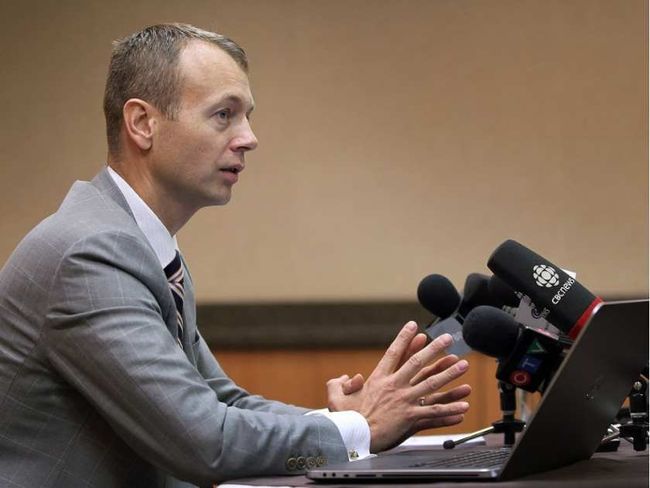In the Trenches against the Church
By Grant LaFleche
Robert Talach knows Donald Grecco. He knows what the former Catholic priest and convicted sexual abuser did. He knows why other men of the cloth did the same thing. For 15 years, the London, Ont. lawyer has represented the victims of clergy abuse, including Grecco’s. In that time he has interviewed many priests convicted of sexual crimes against minors. In their explanations and excuses, he sees a repeating pattern. “(Grecco) was a broken man,” said Talach, who interviewed Grecco in prison in 2010, but said he cannot legally disclose what they discussed. “Those that go into the priesthood in most cases, in my assessment, ain’t always for the right reasons, and when you’ve done that for a decade or more in the priesthood, that is a pretty hollow life.” Talach represented Grecco’s victims during civil litigation against the former priest and the St. Catharines Diocese. The details of the suit’s conclusion are covered by a non-disclosure agreement. However, during Grecco’s sentencing hearing Thursday, the former priest’s lawyer Robert Yanch told the court that as a result of civil litigation, any church pension Grecco may have been entitled to now goes to his victims. While having abusive clergy is not unique to the Catholic church, its theology and organisational structure make the problem more acute, harder to root out, and the task of getting reparations for victims more difficult, Talach says. The problem is what he calls the “unholy trinity” of the church: Priestly celibacy, sexual immaturity and the culture of secrecy within the church. “It is this perfect cocktail of secrecy, sexual repression and psychosexual immaturity that lets these things just go crazy,” he says. “I have dealt with cases in other institutions, and it never gets this bad.” For men who find themselves sexually attracted to children, the clergy served as an ideal place to hide while instantly gaining respect and status in a community. “A great place to go and hide was the seminary and the priesthood because you would not be looked down upon in any way. You’d elevate yourself to heroic status. ‘Oh, look at Uncle Bob. He gave up sex for the church. He’s such a hero’,” Talach says. “I’ve interviewed many of these guys in prison after the convictions, and they’ve been more than candid with me, and the vast majority really ran to hide in the seminary. The celibacy attracted them for the wrong reasons.” Because most priests enter the seminary at a young age and commit to celibacy, they don’t develop healthy attitudes toward sex. “If you’ve been in a serious relationship ... or you’ve had children or had to raise children, those two things go with being a grown-up. You mature psychologically,” Talach says. “So you have got two parts to it. You have guys who are offending because they’re just this immature being, and you’ve got the guys who are supposed to be in charge of dealing with it who just have no reference point.” The propensity of priests to protect their own completes the unholy trinity, Talach said “In 15 years of just being in the trenches, talking to these guys, seeing the cases ... very few report their brother priest.” Penetrating that wall of secrecy and silence is all but impossible for victims at the time they are being abused. It can take decades before victims come forward and that time lag can have consequences when justice is finally served. Victims are often in their 40s and 50s when they come forward and the priests who abused them in their 70s or 80s, said Talach. The courts often take age into account when sentencing. “The court can’t help but look at him and say ‘He’s an old man. I don’t want to send an old man to jail who’s got health conditions.’” During Grecco’s first conviction in 2010, his ongoing cancer treatments and age were factored into him receiving 18 months in prison where a younger, healthier offender would have likely served more time, he said. Even after the criminal cases are finished and verdicts handed down, reparations for victims can be elusive. Talach said while Rome might be awash in wealth and splendour, it’s the local dioceses that get sued, and they don’t have the deep pockets of the Vatican. “The Catholic Church is organized no differently than a terrorist organization. I say that partly tongue in cheek, but it’s partly true,” Talach said. “They’re compartmentalized like they’re in cells ... So even though there are massive wealth and paintings and gold murals in St. Peter’s in Rome, we’ll never be able to touch that.” Talach said there are dioceses in Canada that are facing financial collapse because they cannot afford settlements awarded against them and insurance companies will no longer take the risk of insuring them. --- New hope for male victims of sexual abuse Bringing a predatory priest to justice is only half of the equation when it comes to abusive clergy. Long after the final gavel falls, the victims are still left picking up the pieces of their lives. While the victims of clergy abuse can be of any gender and any ages, historically they have overwhelming been young boys. And there are fewer community resources available for male victims of sexual abuse than there are for females, says Cheri Huys, volunteer coordinator for the Niagara Region Sexual Assault Centre. Next month, the centre is going to do its part to address the issue with the launch of its first therapy group for male victims of sexual abuse. Huys said because it is a therapy group, men will have to call the centre for a screening appointment at 905-682-7258. She also said there are other counselling resources at the centre and its 24-hour crisis and information line at 905-682-4584.
|
.
Any original material on these pages is copyright © BishopAccountability.org 2004. Reproduce freely with attribution.
